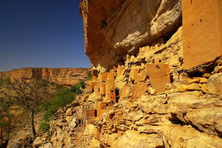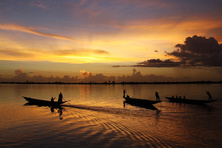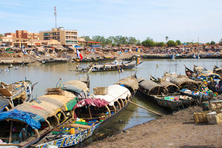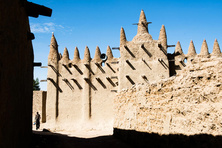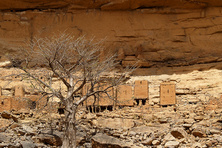Mali
- Currency: West African CFA franc
- Time: UTC+0
- Languages: French
- Religions: Islam (Sunni)
- Sections: Get in Visa Customs Cuisine Money Details of interest Popular resorts
The Republic of Mali is situated in West Africa. It shares its borders with Senegal, Algeria, Mauritania, Niger, Burkina Faso, Guinea, and Cote d’Ivoire. The capital city is Bamako.
The climate in the country is tropical continental and is characterised by the presence of two seasons: wet and dry. The average annual temperature varies from +20 to +35°C. The best time for travelling to Mali is November.
The official language in Mali is French. However, the majority of the population speak Songhai, Bambara, Arabic, and Tuareg. Almost 65% of the population practice Islam and only 1% are the Christians. The rest practice traditional religious beliefs and cults.
Mali is one of the poorest countries in the world and tourism is not developed here well. However, the tourists who prefer excursions and ecological tours will their journey to this African country. In the capital city Bamako, the tourists will see true masterpieces of architecture. Among the most interesting sights are the rock art which presumably dates back to the Neolithic Period. There are medieval buildings such as the Grand Mosque of Bamako. The Bamako Cathedral and a magnificent Presidential Palace with a wonderful garden are must-visit places in Mali.
Visit the Baule national Park to enjoy the nature. This is the only green place in the country where giraffes, lions, hippos, and wild oxen live.
The tourists can go shopping to the local malls in Gao, Mopti, Djenne or Timbuktu.
Get in
By Plane
There are no direct flights from Russia and other CIS to Mali. The tourists will have to choose transit flights with a transfer in Europe. Air France offers a convenient route with a stop in Paris.
The national airline company Air Mali offers the flights from African and some European cities such as Rome, Paris, London, Madrid, Asmara, Dakar, Kampala, and Djibouti.
By Land
A bus regularly runs between Mali and its neighbouring states.
There is a train running between Bamako and Dakar.
By Sea
When the Niger River floods (it happens in August and lasts until January) the tourists can get to Mali by ferry departing from Guinea.
Visa
To travel to Mali, the EU and CIS travellers must obtain a visa.
In real life, many tourists come to Mali without a visa and on arrival, they fill in a blank form to get a visa. They submit this blank to the nearest prefecture and get a visa stamp.
We still recommend obtaining a visa beforehand as there are cases of extortion payments for a visa.
A visitor visa can be obtained in a visa centre or the Embassy within 1-2 weeks. The visa is valid for 90 days.
The tourists can extend their visit by applying to the Ministry of Internal Affairs of Mali.
Customs
In accordance with the Customs legislation, personal belongings are not subject to the Customs duty.
The import and export of foreign and national currency are not restricted. The tourists are not required to fill in the declaration form.
There are no special rules concerning the import.
The tourists are not allowed to export:
- food;
- plants, exotic birds, and animals.
Art objects and antiquities, any jewels, silver and gold are subject to the Customs inspection.
To travel to Mali, the tourists must have a yellow fever international vaccination certificate.
Cuisine
The national cuisine of Mali is very simple. The staple food is rice and grains (sorgo or millet). On the north of the country, the most popular dish is Couscous.
The tourists will find the meat cooked in Mali to tough and not well done. The most eatable meat dish in Mali for the tourists is probably kebab made of beef liver Brochettes.
The tourists can try fish dishes. In the northern districts, the tourists will be served lamb and beef. During your trip to the Tuareg people, you will have a chance to try exotic boiled and roasted camel meat.
There are no desserts in Mali so those who have a sweet tooth should be content with fresh fruits.
Although the majority of the population are the Muslims, they are allowed to produce alcoholic beverages. Castel and Flag are the most popular beer brands. The Dogon people make low-alcoholic maize and millet beer.
Among the non-alcoholic drinks the locals prefer the tamarind juice, cold Hibiscus drink Bissap and ginger lemonade Gingambre.
Money
The national currency of the Mali Republic is the Western African Franc (XOF).
The travelers can exchange the currency at banks or in exchange offices but the commission is very high. If you get to Mali from Senegal, Niger or Burkina Faso we strongly recommend exchanging the currency there.
Credit cards and travelers checks are accepted at large banks and in hotels in Bamako. Visa and MasterCard are preferable. The best exchange rate is available for the cards and checks issued by the French banks.
Details of interest
Customs and Traditions in Mali
The most famous tribe Tuareg call themselves “the offspring of the Queen” and the signs of matriarchy are still echoed there. The girls from this tribe can learn to read and write but education is not obligatory for a man. The women own the lands, valuable things and can divorce their husband if they wish. The Tuareg people are the only tribe where a man must hide his face from the strangers. The Tuareg believe in the spirits of the ancestors and dance ritual offerings dances to please them. Excursion trips are arranged for the tourists and they can learn more about the everyday life and the customs of the African tribes.
Sightseeing in Mali
If you travel to Mali, you must visit the four sites which have been inscribed on the UNESCO World Heritage List:
- In the Mopti Region, the tourists can visit the Old Town of Djenne. You will be under a great impression of the architecture and of the Great Mosque of Djenne. The tourists can also visit the Bandiagara Escarpment. This natural monument is also known as the Dogon plateau.
- Visit Timbuktu, the city founded at the beginning of the 21st century by the Tuareg people. Timbuktu served as an encampment for the caravans.
- In the city of Gao, there are many archaeological and historical monuments. Anyone can visit the Tomb of Askia or the Mausoleum of Askia Muhammad I who founded a legendary Songhai Empire.
- In Mali, there are 9 other natural and architectural UNESCO candidate sites:
- In the Koulikoro district, there is the Boucle du Baule National Park, a 4-meter building of Kamablon, and the Kouroukan Fouga.
- If you stay in Mopti, do not miss a chance to see the Grand Mosque of Mopti and the city of Hamdullahi, the capital of the Madina Empire (the end of the 19th century).
- The tourists who enjoy historical monuments, can go to the Fort in Medina built in the Kayes Region.
- During your trip to Kidal Region, you will learn more about the life and traditions of the Mali people living in the Essouk commune.
- In the Segou Region, anyone can see all the magnificence of the Great Mosque Niono.
- The city of Sikasso built at the end of the 18th century will leave great impressions.
Souvenirs in Mali
- Ivory figurines are sold in Segou.
- In Djenne, anyone can buy masks made of tea tree.
- Pottery and clay crafts are sold in Mopti.
- Go to Bamako and Timbuktu to but wool carpets and bright textile.








